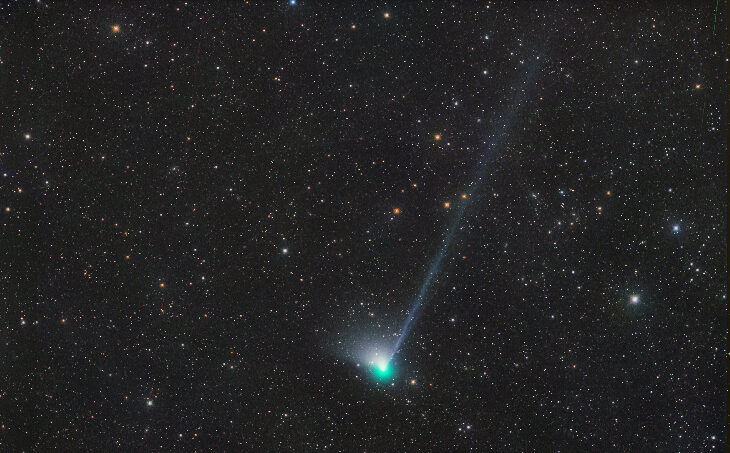
Taken by Michael Jaeger on December 22, 2022 @ Jauerling, Austria
"This comet has become an exciting object," says Jaeger, "Although it will not reach maximum brightness until late January or February, it already shows two tails and a bright green atmosphere."
Discovered in March 2022 by the Zwicky Transient Facility, Comet ZTF is falling in from the outer solar system. Perihelion (closest approach to the sun) will occur on Jan. 12, 2023, at a distance of 1.11 AU. Closest approach to Earth follows on Feb. 1, 2023, at a distance of 0.28 AU. Between those two dates, the comet could hit magnitude 5 or 6, technically visible to the unaided eye.
The two tails Jaeger saw are the dust tail and the ion tail. The ion tail is made of gas and is blown directly away from the sun by the solar wind. The heavier dust tail is curved and more closely traces the comet's orbit.
According to Jaeger, the comet is currently 8th magnitude, which makes it an easy target for mid-sized backyard telescopes. A New Moon over Christmas weekend will provide dark skies for comet-finding. Point your optics here.
More images: from Alan C. Tough using a telescope in Mayhill, New Mexico; from Johnny Barton of Robinson, Texas; from Graziano Ventre of Bellagio Via Lattea, Italy
CRYOVOLCANIC COMET OCCULTATION
What are the odds? For the second time in little more than a week, cryovolcanic Comet 29P/Schwassmann-Wachmann is about to occult a star, giving astronomers an opportunity to trace the comet's strangely spherical shape. The shadow track on Dec. 27th cuts across many populated areas in western USA:
"This event may prove to be the best this decade, so observers please do try and cover it," says Dr. Richard Miles of the British Astronomical Association, a leading researcher of 29P. "It involves a 13th magnitude star," with occultation times range from 12:20:10 UT in San Antonio, Texas, to 12:21:30 UT in Redding, California.
"A video record, preferably with absolute timing, is required," he adds. "Frame exposure times of 0.25 sec or shorter are recommended. The current weather forecast suggests that the north-western half of the track will be plagued by cloud. Most of New Mexico and Texas look to have largely clear skies early on the Tuesday morning."
For updates, check the MISSION 29P website.



Comment: See also: